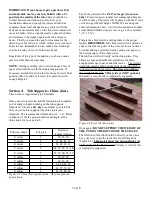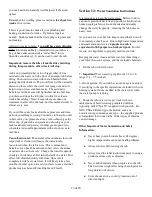
2. Drain
ALL
parts of the heating system. This
includes pump, filter, heater and pipes. Open the
plumbing at union connections closest to the
lowest point in the plumbing to help with this.
3. If practical, disconnect and store the heating
system in a warm dry place.
Preserving the beauty of cedar. Re-apply wood oil (e.g.
teak oil) to the exterior and rim and furniture wax to the
rim as per the “Finishing the Exterior of your Tub”
section in this manual.
Section 15: Tub Troubleshooting
If your tub develops a significant leak. Follow these
steps in order.
If the first one doesn’t work, go on to the
second and so on.
1. If your tub develops a leak (not just a drip) that it
didn’t have before, something has changed. Do some
investigation to discover the cause. The most common
causes are the tub was not assembled and installed
properly. Review this manual and check that the tub was
installed and assembled properly.
Another common cause is the tub has dried out after
being empty for a period of time. If this is the case, follow
the tub swelling process found in the “Adding Water”
section of this manual.
If these aren’t the causes it is most likely that the tub
foundation has settled causing the tub to have an uneven
base or the tub wall to press into something nearby.
2. If the tub has dried out from being left empty, check
the retention bands for tightness. If the wood has dried
enough to show signs of shrinkage, it is a good idea to
take up the slack with the tightening bolts.
NEVER
tighten the bands when the tub is full of water! Tighten
the retention bands according to the “Retention Bands
Tightening” section of this manual.
3. Check the floor of the tub with a level and inspect the
foundation and chine joists under the tub. If the
foundation is uneven, the tub will need to be drained and
moved, and the foundation problem fixed.
4. Once more substantial problems have been ruled out
and if the tub has been full of water for at least two
consecutive weeks, persisting leaks (drips, not runs) can
be solved by flour-consistency
wood sawdust.
It is a
simple and effective way to stop leaks. This is a
technique borrowed from wooden boat builders. The
wood dust will find its way into the leak because of the
water movement, and help to stop the leak.
Included with your tub was a small bag of fine wood
sawdust. If you can’t find it or need more, you may be
able to find some locally at a woodshop or we can send
some to you. It doesn’t have to be cedar, but it does have
to be flour-like consistency; very fine.
Important: remove the filter from the filter cartridge
during this procedure, otherwise it will clog.
Add a cup or two of fine sawdust to the water, or if the tub
is empty, spread it around the bottom corner all around
the tub and then fill with water.. The wood flour will be
naturally drawn to places where the water is seeping out
and will help to stop or slow stubborn leaks. The sawdust
is harmless and the excess will be flushed out the first
time you drain and rinse the tub. Note: It may take more
than one treatment to slow or fix the leak, but this method
works in almost every case.
Give it time
, a week per
treatment, and if necessary 2 or 3 treatments.
5. If the above solutions have not worked, drain the tub
and allow the inside to dry for a few hours. Apply a small
amount of silicone to the leaking area on the inside of the
tub, and around the inside corner where the floor meets
the sides. The surface of the wood must be dry for the
silicone to adhere.
For troubleshooting information related to the hot tub
system, please see the manual(s) specific to that
equipment which was provided.
15 of 16


































